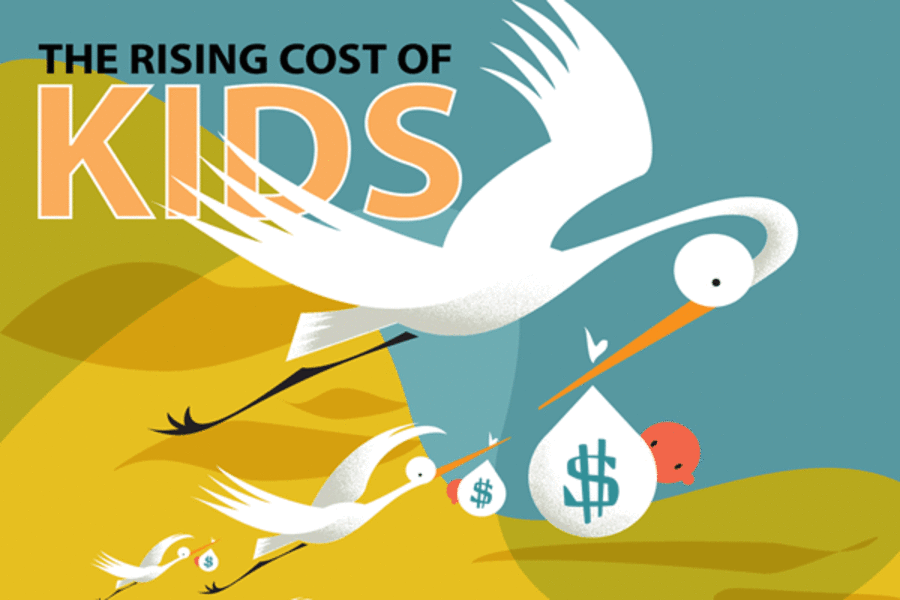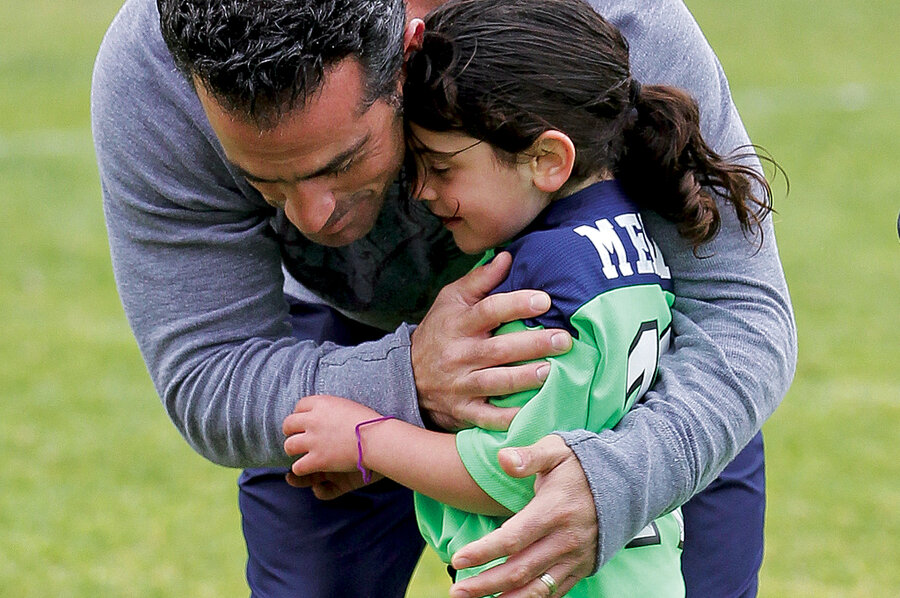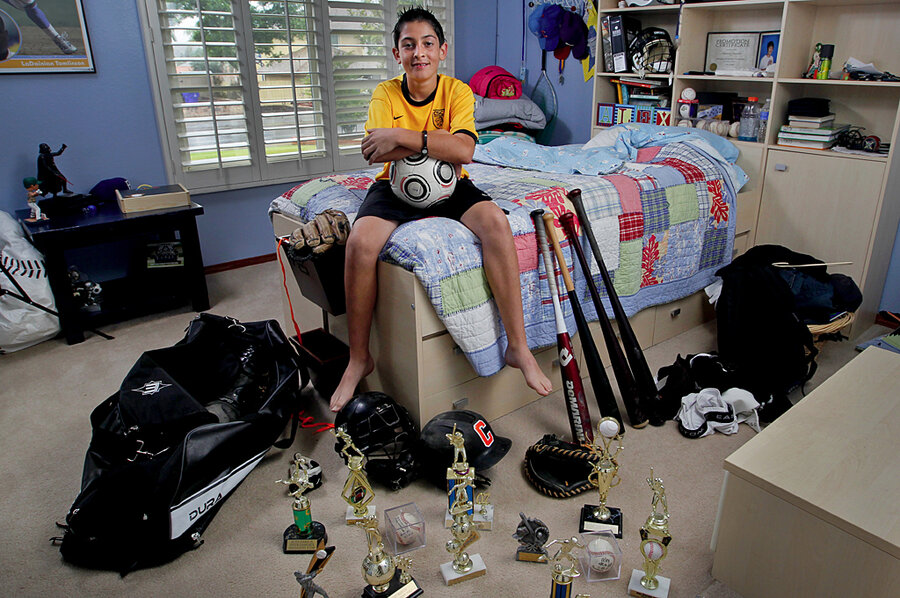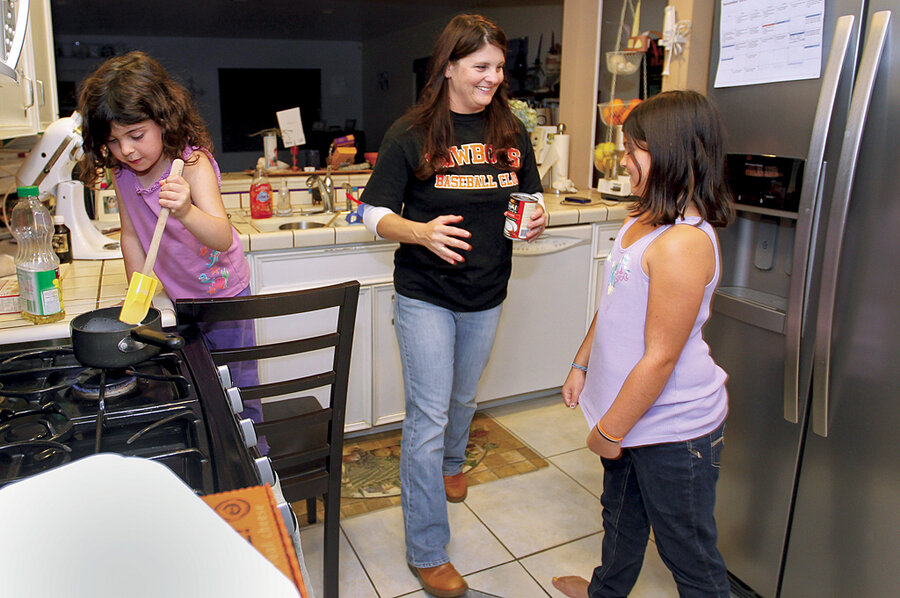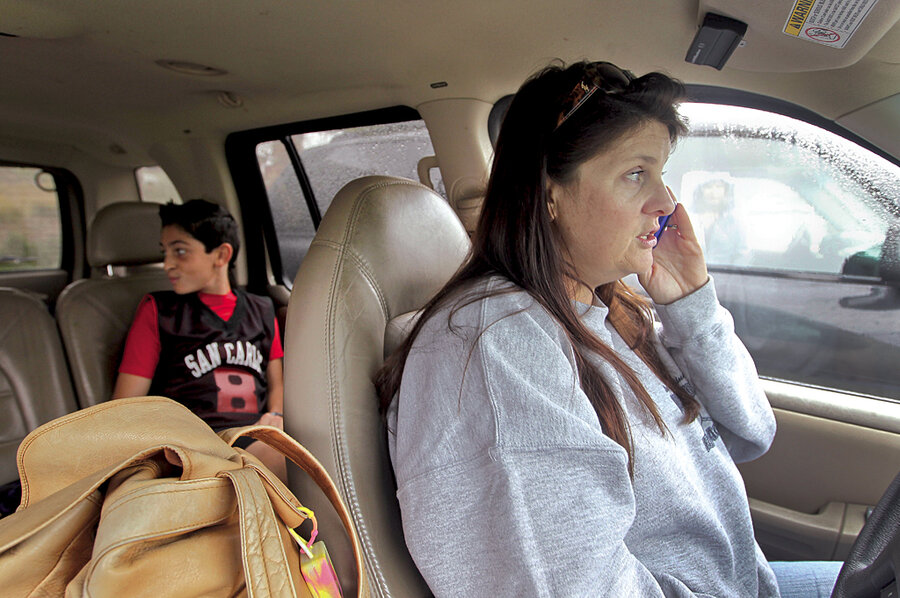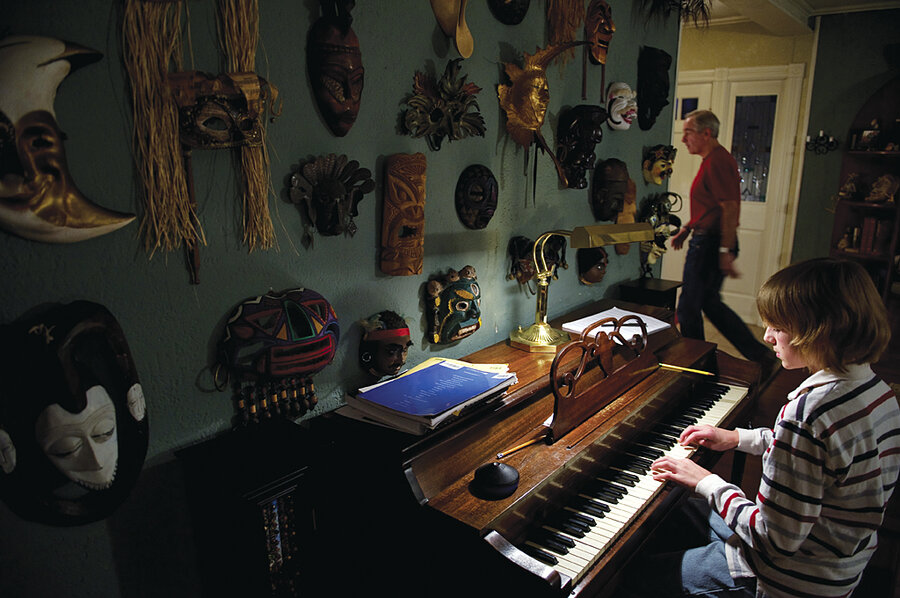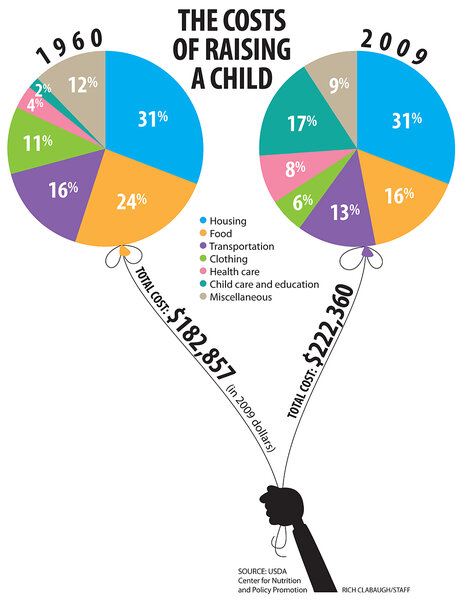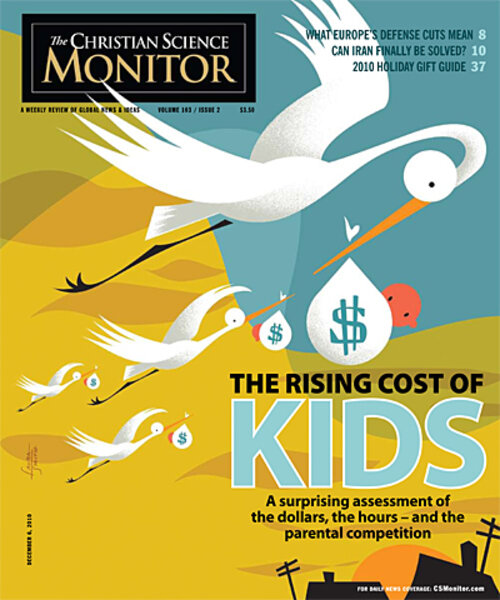Beyond the scary Christmas list: the full parenting price tag
Loading...
| San Diego
In the equation of life, few parents ever really do the math on the actual dollars-and-cents cost of a child. Sure, the holiday season rolls around and they know that Xbox or that iPod Touch on a kid's wish list is going to tax budgets; sure, the looming cost of a college education can sap some enjoyment from a family vacation. But few parents would guess that the average American child costs more than $200,000, and that's before college even starts.
The calculus of kids can be gauged, for example, in one recent weeknight scene in the busy life of the Gianulis family. Theirs is a very middle-class equation that involves love and a striving to give their kids healthy, enriched lives – their own version, they say, of No Child Left Behind.
The setting is their spacious three-bedroom, 2,100-square-foot suburban home in a neighborhood chosen for the good schools (median home price: $379,000). The kitchen is sizzling as Samantha Gianulis cooks up a comparatively costly meal, both in price but also in the time she devotes to it: steamed green beans (organic, $1.60 a pound, about 50 percent more than regular beans), whole wheat pasta shells ($2.50 a bag versus the 50-cent special on store-brand pasta), and tomato sauce she makes from scratch (organic tomatoes for $2.10 a pound and extra virgin olive oil, the good stuff at $12 a bottle); time invested is about 10 times that of opening a can of SpaghettiOs. Her oldest, son Alex, age 11 – just in from baseball practice (team fees: $1,000 a year) – watches TV with Dad – Pete – who is resting up from a weekend injury he got while coaching all three of his kids' soccer teams (fees for three kids: $600 a year, plus about 50 hours of Dad's time). On the floor is Alex's baseball mitt (somewhere between $30 and $150); he hopes that Christmas will bring him a much-coveted big barrel bat ($300).
Everyone knows having children ups life's financial ante, and while parents may not figure it out to the dollar, the US Department of Agriculture does: By the time Alex turns 18, Mr. and Mrs. Giulianis will have spent somewhere around $222,360. That's the cost the USDA figures for the average middle-income couple raising a child from birth through age 17. And it's 22 percent more, in real dollars, than parents spent in 1960 – in the thick of the baby boom – when the USDA started counting such things and when kids shared bedrooms, had one pair of shoes, ate TV dinners and Wonder bread sandwiches, did homework with encyclopedias, didn't go to the doctor – let alone medical specialists – for much more than vaccinations or a broken arm, and went out to play unsupervised. ("Just be home by dinner!" called stay-at-home moms who did their own housekeeping but no helicoptering).
Although the lion's share of parental spending today goes to housing and food, health care and education have both ballooned: Health care is now 8 percent of the cost of raising a child versus just 4 percent in 1960. Education – which includes child care and extracurricular activities – rose from 2 percent to 17 percent of the total childhood bill.
Some economists say that costs are higher than the USDA estimates because so many expenses aren't included, such as the cost of helicopter-parenting, high-speed Internet access, unlimited smart-phone texting, and ergonomic diaper bags, to name a few.
Much of the spending on behalf of children, say parents and economists, goes toward easing a rising panic – concerns that if they don't fork over for educationally enriching activities, sports, tutors, musical instruments, and orthodontia, their kids won't get into the right college and, in turn, won't have a good life.
"I think there is this contemporary mind-set that kicks in when you become a parent," says Brett Graff, a former US government economist and editor of Miami-based HomeEconomist.com. "You're told, for instance, if you don't buy this particular thing, your child won't get into college."
So American parents buy bigger houses; devise enriching experiences; engineer quality, actively engaged time for their kids; and purchase designer gadgets – all to ensure their children will be the kind of adults they want to hang out with and who, while they are growing up, their peers want to hang with, too.
• • •
Certainly, the poor and working classes don't have the option of panic spending, observes Annette Lareau, a sociologist at the University of Pennsylvania who wrote the book "Unequal Childhoods: Class, Race, and Family Life." With scarcer resources, they spend on food, shelter, and clothing – not on organized sports and enrichment activities.
This anxiety-fueled spending may be unique to the broad middle and upper-middle classes, but inasmuch as it has become iconic behavior portrayed in the media – and because broad swaths of American working and lower classes aspire to middle-class models – it has become something of a good-parenting standard.
Whereas middle-class children are often treated as a project to be developed, writes Ms. Lareau, children in less affluent circumstances are given boundaries for behavior and then allowed to grow. "These families aren't involved in the more competitive spending," she says.
But it's not as if the Gianulises are rich – he is a pest-control technician and she is a food writer with a column on FamiliesOnline.com. But when it comes to their children, they open their wallets. Mrs. Gianulis estimates she spends $800 a month on food for her three, because eating well and healthily – the subject of a book she wrote – is important to her. She admits that when she and her husband started a family, they figured their biggest expense would be college.
"Then my kids wanted to play every sport under the sun," says Mrs. Gianulis. That has translated to thousands of dollars a year on fees, equipment, and gas. And it's just a small slice of the family's kid-related expenditures, which include things like mortgage payments, school supplies, summer camps, pediatrician bills – and Christmas.
Most families in the United States spend about $450 per child for Christmas, according to market research firm NPD. Mrs. Gianulis is budgeting about $400 for each of hers – for one big gift and several smaller ones.
"Alex," she says, smiling and wiping her hands on a dish towel, "will probably get that big barrel bat he wants."
• • •
Parents may not be as selfless – or indulgent – as the flapping of open pocketbooks might suggest, says sociologist Lareau. American parents spend plenty on instant gratification for the kids, but they are spending increasing amounts to shape their children into a particular kind of adult, she says.
The phenomenon has a name: concerted cultivation. This category of spending constitutes an increasing chunk of the cost of childhood.
Parents, says Lareau, are "determined to make sure that their children aren't excluded from any opportunity that might eventually contribute to their advancement."
Travel, for example, is very important to the way Sabine Steck and Larry Tift want to raise their children – Simone, 12, and Ethan, 9. "When we are away from our day-to-day lives, we are more engaged as parents and less uptight as a couple," says Mr. Tift, a university librarian's assistant. The San Diego couple have taken their kids as far as Tokyo, but also to British Columbia, Mexico, and Hawaii.
"We think travel is hugely valuable for our kids," says Ms. Steck, a real estate agent. "I grew up that way and think what I learned through traveling has given me a much richer perspective in life. We want [our kids] to grow up interested in the world and not ethnocentric."
The cost for that? About $10,000 a year.
The Steck-Tifts' child-rearing ethic extends to dining out, too – a way they expose their children to different kinds of foods, such as Indian or Japanese. It costs them about $2,400 a year.
It takes more than sushi, though, to cultivate a well-rounded child, and Steck and Tift have also paid for activities like martial arts, piano and flute lessons, drama, swim team, and soccer. Costs vary from $110 a month for swim team to $300 annually for soccer to $400 a year for drama. And, says Steck: "We use both the public library and the university library where Larry works, and yet we still spend about $500 a year for each child on books and music.
"Everything costs more than you think it will with kids," adds Steck, who is feeling it keenly now, as the real estate market in which she works is depressed.
Ms. Graff, the HomeEconomist.com editor who has two young daughters, observes that marketing to perceived parental vulnerabilities can fuel concerted cultivation: "As parents we care about our children more than anything else. And when there's a vulnerability, there's someone who wants to make money off of it."
Parents who have the money to spend hardly feel duped by marketing; they most often feel they are deliberately trying to stimulate their children's development and foster cognitive and social skills, says Lareau.
Alison and Joe Cattelona, for example, believe the arts – music and theater – are an essential part of their children's development, probably because it's a big part of who the Cattelonas are as adults.
Ms. Cattelona runs her own computer-training business, Mobile Mac & PC Training; teaches a class at the School of Visual Arts in Manhattan; and is an artist in the midst of painting a mural of two dragons locked in battle on the ceiling of her boys' bedroom. Mr. Cattelona is a physical therapist with the New York City schools but for many years worked as an actor.
They and their three children – ages 17, 14, and 11 – live in a modest house in a wooded, upper-middle-class neighborhood in northern New Jersey. Their middle child, Jordan, is musically gifted. Since he was very young, his parents have poured money into lessons and instruments to help develop his talent. Their other two children also receive music lessons.
"It's $220 a week for jazz piano and guitar lessons, almost a thousand a month," says Mrs. Cattelona. It's not just about the music, though. "We also see it as a way to build character around commitment. They can play any instrument they want – we will financially support that. But if they make a commitment to it, they stick with it. They can't just give it up because it got boring or difficult and then try something else."
For birthdays the children get tickets to a Broadway show with one parent and can also invite a friend or get a small gift – which means each birthday costs between $200 and $300. "Bottom line is, we want them to value the arts and experience the arts over material things," says Mr. Cattelona. "I want them to grow up and spend their money on experiencing the world, rather than new gadgets."
Parents also funnel cash into competitive sports, academic tutoring, private school, and brand-label clothing – all of it to ensure their kids are successful in school and life, and that they fit in with peers.
Some estimates put the number of kids playing in organized sports in the US at 40 million, because parents believe playing sports is both important for character development and looks good on a college application. Those fees, however, add up. If you want to play basketball at Arlington High School in Arlington, Mass., for instance, it will cost you $480 a child just to be there (not including the cost of equipment and uniforms); to be a part of the cheerleading squad, it's $408. A mother who lives in the next town over from the Cattelonas in New Jersey says she pays about $5,000 a year for fees, equipment, and travel for her 17-year-old daughter to play on two basketball teams and a soccer team.
Wealthier parents spend money just to ensure their kids do their homework, hiring tutors that really function as homework monitors for about $100 an hour, reported The New York Times recently.
Mrs. Gianulis, in San Diego, says she feels social pressure to encourage every interest in her children or risk cutting off a future opportunity for them: "There is this belief that if you don't nurture whatever potential you think could exist within them, if you don't let them try everything, they will never find their calling."
Parents also spend money on status symbols – think a iPhone 4, the Coach backpack, the Tory Burch sandals – to help their children fit in.
Although clothing is a status marker for kids, its real cost hasn't increased much over the years, says Daniel Cook, associate professor of childhood studies at Rutgers University in New Jersey and the author of "The Commodification of Childhood." Styles have become so nuanced it's difficult to pass clothes down from one child to another: The difference between clothing styles for a 3-year-old and a 6-year-old is far more pronounced today than it was 30 years ago, he says.
There's also been a proliferation of branded, status-symbol sportswear for tweens and teens. That's especially hard for children in mixed-income neighborhoods whose parents feel tremendous pressure for their kids to fit in socially, says Stephanie Coontz, a professor of history and family studies at The Evergreen State College in Olympia, Wash., and author of several books on the history of the American family, including "The Way We Never Were: American Families and the Nostalgia Trap." "Some parents I've talked to express this sense that since they can't give their kids the other opportunities, the least they can do is get them the latest fashion in shoes," she says. "It may seem irrational to people who can afford to save up for the bigger, more educational experiences, but the pain these parents feel about their inability to compete is palpable, and they end up feeling they need to spend more than they ordinarily would on shoes and things like that because they can't afford the others."
• • •
Housing has always been the biggest chunk of child-rearing costs, at a steady 31 percent. Even though the size of the average American family has shrunk from 2.2 children per married couple in 1955 to 1.93 in 2009, the size of the average family's house has grown. This trend accelerated after baby boomers started having kids, mothers entered the workforce, and families made a beeline for the suburbs. These days the norm for the middle class on up is that each child has a bedroom of his or her own, and that adds substantially to the cost of housing, says Mr. Cook.
In choosing a house, parents are also buying schools, whose quality can vary greatly from neighborhood to neighborhood. Many parents buy an expensive house not for the extra bedrooms but for the school system, says Ms. Coontz.
Although health-care costs are a relatively small percentage of expenditures on children, they have doubled since 1960, largely because of insurers requiring parents to pay a larger portion of their doctor's bills. Also, the actual cost of health care has gone up in real dollars. And, explains Mark Lino, the USDA economist who oversaw the research on family expenditures, parents are simply taking their kids to doctors more often. What is considered standard care now – consulting allergy specialists or getting an MRI for a head injury – was not standard care back in the 1960s.
A stealth expense hard to even calcULate in dollar terms is the time parents spend with kids. Because parents today are more actively engaged with their kids than parents in 1960, this time – variously called "quality time" or "face time" – is considered more valuable."
Child care used to be largely supervisory, a background activity by Mom, who was busy making dinner or cleaning the house. "Families spent more time in the same household back then but [they] weren't actively engaged with each other. Now they are," says economist Nancy Folbre, a professor of economics at the University of Massachusetts and author of "Valuing Children: Rethinking the Economics of the Family." In fact, supervisory time is considered of so low value that it's often not even counted in time surveys, she says.
Ms. Folbre calculated a very lowball dollar value of all time parents spend with their children – not differentiating between engaged time and supervisory time – using a minimum-wage replacement for parents. She found that for children living in a two-parent, middle-income household, the annual cost of parental time ranged from $12,353 to $14,338, depending on the age of a child.
"This is what the time would cost you, regardless of the reason you do it, whether it's love or obligation," she says. Her research shows time costs are about 60 percent of the total cost per year of raising a child, and that is just the replacement cost, not the opportunity cost, which is the income a parent gives up by choosing to stay home with a child.
Valerie Ramey, a professor of economics who co-wrote this fall's Brookings Institution report, "The Rug Rat Race," says the average time spent with children declined gradually from the 1960s to the late 1980s, as more women entered the workforce. But in the 1990s, "it really took off," she says. "The Rug Rat Race" argues that the increase in time correlates with increased competition for college admissions in this country.
With both parents working in many families now, parents tend to spend the time they do have with their kids doing things together. Some of that time, though, is spent driving children to activities or watching them participate in those activities.
"The Rug Rat Race" found that college-educated mothers spend an average of nine hours more a week with their children now than they did in the late 1980s. For less-educated mothers, that increase is four hours a week. Time expended on children also increased among fathers, says Ms. Ramey.
Research by Ramey and her coauthors – which relied on time diaries kept by parents – suggests that time spent actively engaged with children by the entire adult population in 2008 was equal to almost 20 percent of time spent working.
• • •
Given how expensive it is to raise a child, it would make sense for families to be having fewer, especially during a recession. Indeed, historically, hard economic times correspond to a dip in fertility rates. And a Pew Research Center survey last year found that 14 percent of 18-to-34-year-olds said they postponed having a child because of the recession. A Guttmacher Institute study in 2009 found that 44 percent of women wanted to either reduce or delay childbearing because of the economy.
"Ultimately, I think the decision to have a child is very complicated, and although money is part of it, fertility goes up and down regardless of economic conditions or the fact that the cost of raising a child has been increasing," says Jennifer Manlove, a senior research scientist at Child Trends, a research organization focused on children and families.
Yet the fact remains: Even as families shrink, the amount spent on children increases. That might be a result of having more to spend, says Ramey. Despite the current recession, average incomes have actually gone up in real dollars since the 1960s, she says, especially in households where both parents work.
Ramey and her husband, also an economist, have two children, a 21-year-old son in college and a 16-year-old daughter attending a pricey private high school in La Jolla, Calif.
"My husband and I have much higher incomes than our parents did and we are ridiculous with the credit cards. We just got our daughter a car for $14,000," says Ramey. When her son was younger and took flute lessons, she bought him a $1,500 silver flute because "he was really good"; when their daughter showed an aptitude for photography, they bought her a Nikon D90 camera for $900. "It's kind of scary," she says, "the way you think if everyone else is doing something for their kids, you have to do it, too."
Yet Ramey also came to the realization that in the long run, all the spending she was doing might not benefit her kids as much as she thought. "One day my husband said to me, 'I know you're competitive, but these other mothers are competing to see who can spoil their child the most, and that's one competition you don't want to win.' And he was right," she says. "I didn't."



